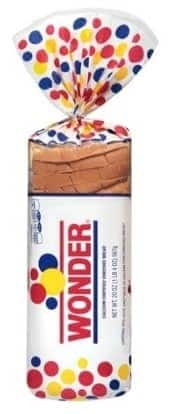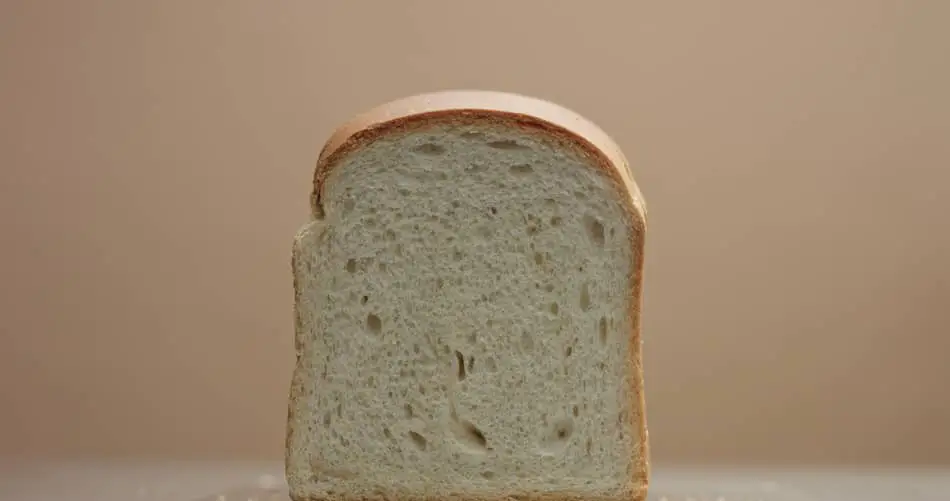I commonly get asked about the vegan status of white bread. There are two types of white bread, one that’s undergone milling to remove the brown components, and the other being the kind made with bleached flour, but is otherwise whole grain.
I’d imagine that this question comes up because white bread undergoes more processing, which means it’s likely had more things added to it, compared to other types of bread.
Is it vegan? Yes, white bread is usually vegan by default. However, there are some ingredients you’ll need to look out for—namely, milk products and vitamin D3. While most white bread is vegan, it’s always best to scan the ingredients label prior to purchasing a given brand.
Keep in mind, in this article we’re talking about loaf bread. I’ve written an article on white dinner rolls you can check out here.
What we’ll do here is go over the various reasons most white bread is considered vegan, as well as some ingredients you’ll need to be aware of when shopping for white bread in stores. Then we’ll touch on the vegan status of Wonder Bread, a popular brand of white bread that I get asked about specifically from time to time.
Why Most White Bread Is Vegan
White Bread Doesn’t Use Bone Char
Contrary to a popular myth, white bread gets its color from the milling process, and/or the use of bleaching agents—NOT bone char.
White bread usually refers to bread made from wheat flour that’s had the germ and bran layers removed from the whole wheatberry as part of the flour milling or grinding process, which produces the light-color characteristic of all-purpose white flour.1
The above process extends the shelf life of the flour by removing the natural oils from the whole grain. Removal of the oil allows food products (loaves and bakery items) made with white flour, to be stored for longer periods of time without going rancid.
Grains contain unsaturated fatty acids that are easily oxidized which causes them to go rancid quickly.
I’m not exactly sure where the bone char myth came from or how it originated. Ever since awareness was raised about the use of bone char in the processing of white sugar, white powdery substances, started to be looked upon with a suspicious eye.
According to the Vegan Society, folks used to debate whether bone char was used in the processing of white flour, but the claim has since been debunked.2
The main reason bone char is used to process sugar is to remove impurities—remember that raw, unprocessed sugar is actually brown.
The brown components of flour (the germ and bran) are not considered impurities. They’re just elements that some manufacturers want to remove in the milling process to increase shelf life and achieve desired taste and textural properties.
When the bran and germ are removed, it leaves behind the starchy endosperm which is white. Thus, you get white flour.
Then you have the bleaching process that manufacturers use to turn regular whole grain flour white. Bleached flour makes use of bleaching agents (e.g. chlorine gas and benzoyl peroxide). Thankfully, bone char is not a bleaching agent. So no problems here.
The B Vitamins (Via Enrichment) Are Vegan
While the discarding of the bran and wheat germ during the milling process can help improve the shelf life of white flour, it does remove certain nutrients like iron, B vitamins, and essential fatty acids (EFAs).3,4
Since about 1941, manufacturers began to add to white flour some of the micronutrients lost in the milling process, in order to help mitigate some of the nutrient deficiencies that were known to be common around that time. The initial nutrients added include iron, thiamin, riboflavin, and niacin.5
This fortification was very successful and led to almost complete eradication of acute deficiency diseases in the US, such as beriberi and pellagra and white bread still contains these added nutrients to this day.4
Thankfully, the specific vitamins most common in white bread tend to be produced via microbial technology and chemical synthesis—the latter without animal-derived precursors.
In the olden days, they used to extract vitamins from foods that were known to be naturally abundant sources—both plant and animal foods. Much like vitamin D is still sourced from sheep oil.
Newer technologies now allow manufacturers to synthesize vitamins, which means they’re more economically feasible as well as more likely to be vegan-friendly.
B vitamins such as thiamin, riboflavin, and niacin tend to be produced by a combination of microbial and chemical processes.6
So, they’re seen as generally suitable for vegans.
Potentially Non-Vegan Ingredients in White Bread
Now that we know that white bread is generally considered vegan, we need to cover some possible exceptions.
There are some ingredients that run the gamut from:
- Common in white bread and sometimes derived from animals (e.g. emulsifiers and dough conditioners)
- Uncommon in white bread, but always animal-derived (milk derivatives, vitamin D, etc.)
DATEM and Mon-Diglycerides
The former category would include things like DATEM and mono-/diglycerides.
These ingredients are derivative of glycerin or glycerol, a compound listed in PETA’s list of animal-based and potentially animal-based ingredients.7
Mono- and diglycerides are produced by reacting glycerol with triglycerides (three fatty acids and a glycerol backbone), both of which can be derived from both animal and plant sources.8-10
You’ve probably come across DATEM by now when scanning food labels.
It’s an acronym for “diacetyl tartaric acid ester of mono- and diglycerides”.11
It’s a popular food additive in bread products because it’s an emulsifier and dough conditioner—a class of substances used in baked goods in order to strengthen the gluten network of dough, giving bread products a higher rise, and more structural integrity.
So, it’s considered vegan insofar as mono- and diglycerides are considered vegan.
The presence of DATEM, mono-, and diglycerides doesn’t render food products non-vegan by most standards in the community, as they are usually plant-based—again, both glycerin and triglycerides can be sourced from plant foods, namely, coconut, palm, and soy.
But, if you’re an extra careful vegan, then you may want to avoid the stuff.
Milk Products
In her excellent textbook on food science, Understanding Food, Principles and Applications, Amy Brown states that white bread is generally made with all-purpose flour, water, nutrient fortifications, and small amounts of salt, sugar, and yeast.12
She also says that white bread can be made with milk products.12
But in my experience, milk and dairy derivatives tend to be pretty uncommon. I’d imagine she’s referring to rich yeast breads like Hawaiian rolls and Portuguese sweet bread.
But, when it comes to processed foods, milk is always a possibility, so this is an ingredient you should keep a lookout for.
Vitamin D from Lanolin
Some popular brands of white bread use this ingredient (more on that below).
Vitamin D3 is typically considered suitable for vegans as its precursor is usually sourced from lanolin, or wool grease—a waxy substance secreted by the glands of wooled animals.13,14
This one is listed on PETA’s website as unequivocally non-vegan.7
It’s listed as lanolin, by the way, not vitamin D3. But, the two are synonymous, at least until lichen-sourced D3 (a vegan-friendly D3) becomes commonplace in vitamin D3 fortified foods.
This brings us to the next question.
Is Wonder Bread Vegan?

Unfortunately, Wonder Bread is not considered vegan due to the presence of vitamin D3 which is synthesized with a precursor (7-dehydrocholesterol) that’s derived from lanolin sourced from sheep’s wool. While vitamin D2 is vegan, vitamin D3 is almost always animal-derived.15
Specifically, the ingredients for Wonder Bread include:15
- Unbleached Enriched Flour (Wheat Flour, Malted Barley Flour, Niacin, Reduced Iron, Thiamin Mononitrate, Riboflavin, Folic Acid)
- Wheat Gluten, Salt, Yeast, Yeast Extract
- Water, Soybean Oil, Vinegar
- High Fructose Corn Syrup, Modified Corn Starch, Sucrose, Sugar
- Calcium Carbonate
- Cholecalciferol (Vitamin D3)
- Dough Conditioners (Contains One or More of the Following: Sodium Stearoyl Lactylate, Calcium Stearoyl Lactylate, Monoglycerides, Mono- and Diglycerides, Distilled Monoglycerides, Calcium Peroxide, Calcium Iodate, DATEM, Ethoxylated Mono- and Diglycerides, Enzymes, Ascorbic Acid)
- Monocalcium Phosphate, Ammonium Sulfate, Calcium Sulfate, Calcium Propionate (to Retard Spoilage)
- Soy Lecithin and Soy Flour
That’s it for the vegan status of white bread. Thanks for reading.
You may also want to check out the following related articles:
References
- NPCS board (2012-10-01). Manufacture of Food & Beverages (2nd Edn.). Niir Project Consultancy Services, 2012. ISBN 9789381039113.
- Sarah Cook cracks out her top tips and favourite recipes this National Baking Week. The Vegan Society. https://www.vegansociety.com/whats-new/blog/all-you-need-know-about-successful-vegan-baking
- Understanding Food: Principles and Preparation (Page 55). Amy Brown – Wadsworth Cengage Learning – 2011. ISBN-10: 0-538-73498-1
- White Bread. https://en.wikipedia.org/wiki/White_bread
- “Position of the American Dietetic Association: Fortification and Nutritional Supplements”. Journal of the American Dietetic Association. 105 (8): 1300–1311. 2005. https://jandonline.org/article/S0002-8223(05)01034-5/fulltext
- Jose L. Revuelta, Ruben M. Buey, Rodrigo Ledesma‐Amaro, and Erick J. Microbial biotechnology for the synthesis of (pro)vitamins, biopigments and antioxidants: challenges and opportunities. Microb Biotechnol. 2016 Sep; 9(5): 564–567. https://www.ncbi.nlm.nih.gov/pmc/articles/PMC4993173/
- Animal-derived Ingredients Resource: Living. https://www.peta.org/living/food/animal-ingredients-list/
- What Is Vegetable Glycerin? https://www.healthline.com/nutrition/vegetable-glycerin#what-it-is
- Flickinger, Brent D.; Matsuo, Noboru (February 2003). “Nutritional characteristics of DAG oil”. Lipids. 38 (2): 129–132. https://aocs.onlinelibrary.wiley.com/doi/abs/10.1007/s11745-003-1042-8
- Sonntag, Norman O. V. (1982). “Glycerolysis of fats and methyl esters — Status, review and critique”. Journal of the American Oil Chemists’ Society. 59 (10): 795A–802A. https://aocs.onlinelibrary.wiley.com/doi/abs/10.1007/BF02634442
- DATEM Definition. https://bakerpedia.com/ingredients/datem/
- Understanding Food: Principles and Preparation (Page 428). Amy Brown – Wadsworth Cengage Learning – 2011. ISBN-10: 0-538-73498-1
- Hoppe, Udo, ed. (1999). The Lanolin Book. Hamburg: Beiersdorf. ISBN 9783931146054
- Riemenschneider, W.; Bolt, H. M., “Esters, Organic”, Ullmann’s Encyclopedia of Industrial Chemistry, Weinheim: Wiley-VCH. https://onlinelibrary.wiley.com/doi/abs/10.1002/14356007.a09_565.pub2
- Wonder® Classic White Bread 20 Oz. Loaf. https://www.walmart.com/ip/Wonder-Classic-White-Bread-20-oz-Loaf/37858875


